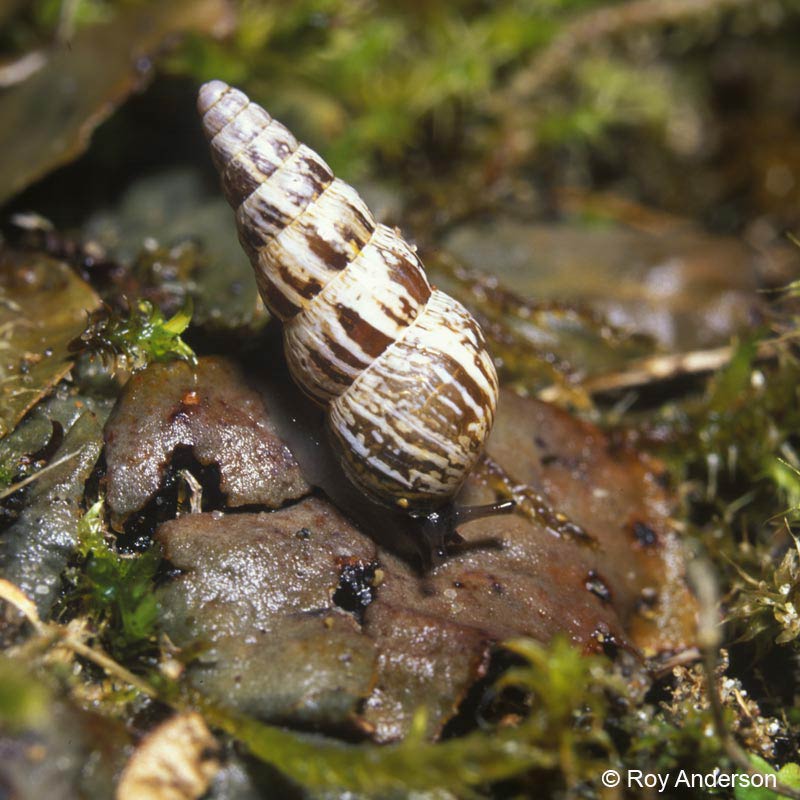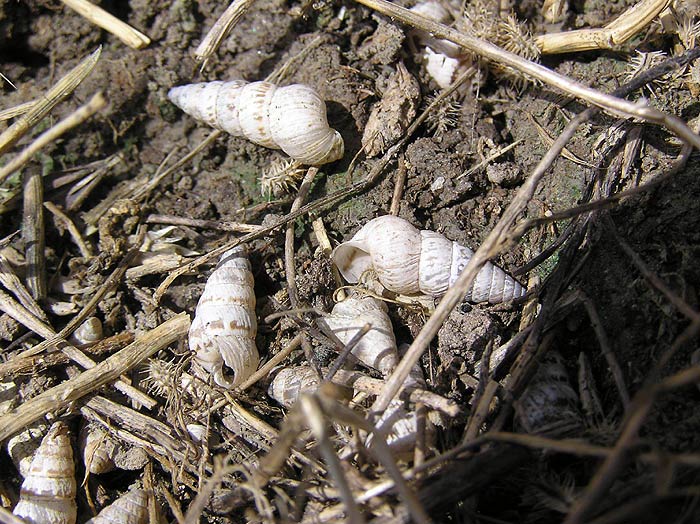Cochlicella spp.
|
Cochlicella acuta. (Photo: © Dr. Roy Anderson, MolluscIreland) |
|
Cochlicella acuta. (Photo: © Dr. Roy Anderson, MolluscIreland) |
|
Cochlicella acuta. (Photo: © J. Novak, www.biolib.cz) |
|
Cochlicella acuta. (Photo: © J. Novak, www.biolib.cz) |
Family
Cochlicellidae
Species
Cochlicella acuta (da Costa, 1778)
C. conoidea (Draparnaud. 1801)
C. ventricosa (Draparnaud, 1801)
Common name
Cochlicella acuta: Pointed helicelid, ConicalConical:
Shell shape: shells with an elongated spire that tapers to a point and are slightly broader at the base.
snail
C. conoidea: None reported
C. ventricosa: None reported
Description
Cochlicella acuta: The pointed helicellid's shellShell:
A hard, inflexible, calcareous or chitinous structure that vary in size and may either completely encasing the animal, covering some part of it or be internal.
is approximately 10-20 mm high and 4-7 mm wide. It typically has a high spireSpire:
All the coils (whorls) of a shell above the body whorl.
, giving it an elongated appearance, hence its name. The color of this snail is very variable. It may range from being completely off-white to having regular brown-colored bands and stripes over the entire shellShell:
A hard, inflexible, calcareous or chitinous structure that vary in size and may either completely encasing the animal, covering some part of it or be internal.
.
C. conoidea: This species is approximately 6-9 mm high and 5-6 mm wide, with 4.5-6 whorlsWhorls:
Pleural of whorl. A whorl is a complete spiral turn/growth of the shell of a mollusc. The whorls are counted from the apex outwards.
. The shellShell:
A hard, inflexible, calcareous or chitinous structure that vary in size and may either completely encasing the animal, covering some part of it or be internal.
is either pale grey or tan with brown spots or bands. There is also a brown-colored stripe at the baseBase:
This is the lower or underside of the shell; opposite of apical.
of the body whorlBody whorl:
The large, final coil (most recently formed) of a mollusc shell that contains the body of the snail, i.e. from the aperture to approximately one whorl back.
. The umbilicusUmbilicus:
A navel-like indentation or depression in the center of the shell. It may be described as open (inside of columella visible), partially closed (partly covered by base of aperture) or completely closed (not visible). The width of the umbilicus is a measure of its greatest diameter.
(navel) is narrow. The body of the animal is apple yellow to tan with a lighter footFoot:
The muscular organ on the undersurface of the body of a mollusc upon which the animal rests or uses to crawl.
. The ocular (eye-bearing) tentaclesTentacles:
Sensory projections on the head end of a mollusc. There are generally two pairs; upper (posterior) and smaller, lower (anterior). The upper pair bears the eyes. In many snails the eyes are located at the tips of this structure; however, in Basommatophoran snail species, the eyes are located at the base of the tentacles.
are very long and the posteriorPosterior:
Directional term: the rear or tail end of an animal.
tip of the footFoot:
The muscular organ on the undersurface of the body of a mollusc upon which the animal rests or uses to crawl.
is pointed.
Native range
C. acuta: Mediterranean region and Atlantic
Distribution
Australasia: Australia
Europe: Spain, France, Belgium, Netherlands, British Isles, Turkey (C. acuta)
Mediterranean: Greece, Israel, Egypt
Ecology
This coastal species prefers sandy and calcareousCalcareous:
Consisting of limestone or calcium carbonate.
soils where it is often found in grassy areas. Under unfavorable environmental conditions, this species will aestivate on vertical structures (e.g., posts, walls). This snail can lay on average 36 eggs per clutch. Cochlicella acuta has been reported as a pest of fodder crops (i.e. alfalfa, clover, lupine).
Synonyms
Cochlicella acuta:
- Bulimus acustus . Zelebor, 1865. Mollusca. In: F. Unger and Th. Kotschy. Die Insel Cypern ihrer physischen und organischen Natur nanch mit Rucksicht auf ihre fruhere Geschichte geschildert: 593.
- Cochlicella acuta. Kerny and Cameron, 1979. A field guide to the land snails of Britain and North-west Europe: on pg. 183, pl.24 fig. 2a, b.
Cochlicella conoidea:
- Cochlicella conoidea, Kerney and Cameron (edition Gittenberger), 1980. Elseviers slakkengids: 1-310. Amsterdam & Brusessel. (on pg. 244. fig. 47).
References
Anderson 2005Anderson 2005:
Anderson, R. 2005. An annotated list of the non-marine Mollusca of Britain and Ireland. Journal of Conchology 38: 607-637.; Barker 2002Barker 2002:
Barker, G.M. (Ed.) 2002. Molluscs as crop pests. CABI Publishing, Wallingford, UK. pp. 1-468.; Cowie et al. 2009; Kerney et al. 1979Kerney et al. 1979:
Kerney, M.P., R.A.D. Cameron and G. Riley. 1979. A field guide to the land snails of Britain and North-west Europe. Collins, London. pp. 288.; Gittenberger 1991Gittenberger 1991:
Gittenberger, E. 1991. On Cyprian Helicellinae (Mollusca: Gastropoda Pulmonata: Helicidae), making a new start. Zoologische Mededelingen. 65(7): 99-128.; Godan 1983Godan 1983:
Godan, D. 1983. Pest slugs and snails. Biology and control. Springer-Verlag, Berlin. pp. 1-445.





